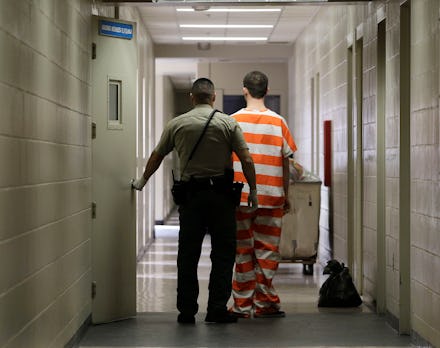The U.S. Prison Population Has Spiked By 27% in the Last 10 Years

The news: According to a new report by the Government Accountability Office (GAO), the federal prison inmate population has ballooned an alarming 27% over the past decade — and much of the increase is due to thankless mandatory minimum sentencing practices for nonviolent drug offenders.
The GAO report states:
"The Department of Justice’s (DOJ) Federal Bureau of Prisons (BOP) is responsible for the custody and care of over 219,000 federal inmates—a population that has grown by 27 percent over the past decade. BOP is composed of 119 institutions, 6 regional offices, 2 staff training centers, 22 residential reentry management offices (previously called community corrections offices), and a central office in Washington, D.C. With a fiscal year 2013 operating budget of about $6.5 billion—the second-largest budget within DOJ—BOP projects that its costs will increase as the federal prison population grows through 2018. […]
A variety of factors contribute to the size of BOP’s population. These include national crime levels, law enforcement policies, and federal sentencing laws, all of which are beyond BOP’s control."
Why you should care: That growing prison population has seen the Justice Department increase its spending on federal prisons from a little over $5 billion in 2008 to very close to $7 billion today. Meanwhile, those prisons are 35%-40% over capacity, and if that trend holds, the Urban Institute expects them to be 55% over capacity by 2023. Over a 25-year period, the average drug offender saw their sentence increase from 38.5 months in 1974 to 74 months in 2011.
During this period, the total number of convicted felons sentenced under the Sentencing Reform Act increased from 59,846 to 83,946. More than half of drug offenders were in the lowest criminal history category. Eighty-four percent of prisoners convicted on drug charges had no weapon involvement.
Althrough drug sentence lengths were falling, this was mainly due to lower average crack cocaine sentences and fewer crack-related prosecutions. Persons convicted on crack charges, however, still received higher sentences than those involved in any other sort of drug:
Why is this happening? In 1986, just 50% of federally sentenced criminals were sent to prison; 37% received probation, and the rest paid a fine.
In 2011, 90% of offenders received a federal prison sentence, and 10% received probation.
Eric Holder's Justice Department has pledged to reduce mandatory-minimum sentencing and enact reforms, but stories like this 22-year-old Louisiana man sentenced to life in prison for a few small-time thefts are commonplace.
Can the trend be reversed? Honestly, it's not likely — "tough on crime" is still a popular campaign theme, and ever-growing powers give prosecutors incredible leverage to use the threat of mandatory-minimum sentencing as a way to coerce guilty pleas out of defendants.
It will take a very long time and a massive change of culture at the Justice Department to reduce federal sentences and the prison population - and that's not even counting state prisons (California, for example, is so overcrowded it literally ships its prisoners out of the state). Conditions in many federal and state prisons remain deplorable.
According to the International Centre for Prison Studies, the U.S. incarcerates more people than any other country in the world — 716 in every 100,000 Americans is in prison, or 1,571,013 people. If you include city and local jails, that number easily surpasses 2 million.